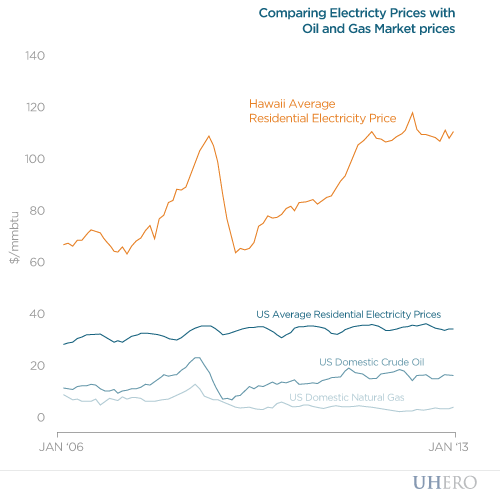Whether visitors or residents in Hawai‘i, we are all aware of the high cost of living in paradise. One major contributing factor is the cost of energy. Households in Hawai‘i pay 4 times more than the average US household and nearly 7 times the households in Utah, where the residential energy cost is the cheapest in the nation.* While the US average for April 2013 hovered at 12 cents/kwh, Hawai‘i paid 37 cents/kwh for electricity in the residential sector.**
Breaking down residential energy consumption by source provides more insight into the high cost of living in Hawai‘i. While households in Hawai‘i supply their energy needs mainly by electricity (90%) at $110/mmbtu (equivalent to 37 cents/kwh), the two major sources in the US—natural gas and electricity—each comprise 42% of energy consumption, at roughly $5/mmbtu (equivalent to 1.7 cents/kwh) and $35/mmbtu (equivalent to 12 cents/kwh), respectively (see Figure 1). Hence, Hawai‘i is not only consuming a larger share of electricity, but also at skyrocketing prices. In contrast, the US is consuming a smaller portion from electricity at significantly discounted prices compared to Hawai‘i. This, combined with a large share of cheap natural gas in the US household consumption portfolio explains the large disparity in the cost of energy—particularly in the residential sector—in Hawai‘i and the US. Note however that switching to natural gas in Hawai‘i is not straightforward because of the logistics and infrastructure costs (liquefaction, shipping, regasification) of bringing natural gas to Hawai‘i.

– Sherilyn Wee
*http://www.eia.gov/state/seds/data.cfm?incfile=/state/seds/sep_sum/html/sum_pr_res.html&sid=US
**http://www.eia.gov/electricity/monthly/epm_table_grapher.cfm?t=epmt_5_6_a